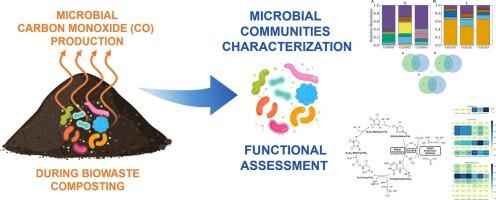堆肥中可能参与一氧化碳产生的微生物群落分析及其功能评估:利用的途径、酶和基因
IF 8
1区 环境科学与生态学
Q1 ENVIRONMENTAL SCIENCES
引用次数: 0
摘要
一氧化碳(CO)是一种广泛应用于工业的有价值化合物,其生物生产符合生物经济原理。本研究通过探索生物垃圾堆肥作为CO生产的潜在来源,引入了一个新的视角。采用16S rDNA测序技术,对低CO/L (119 ppm)和高CO/H (785 ppm)两个区域的堆肥堆微生物群落进行了表征。利用PICRUSt2(一种先进的功能分析工具)研究了微生物群落的代谢潜力。结果显示,与CO/L样品相比,CO/H样品中的α多样性更高,可能受到CO/H采样点温度较低(CO/L为50°C, CO/L为62°C)的影响。重要的是,在PCoA图中,样本聚集在一起取决于采样地点。微生物群落组成以芽孢杆菌为主(CO/L和CO/H分别高达98.8%和55.4%)。其中一个关键的结果是在几乎所有的堆肥样品中都检测到了Wood-Ljungdahl途径,这是一种产生CO的代谢途径。该途径在CO/H样品(0.011 - 0.027%)中比CO/L样品(0.000 - 0.002%)更为丰富。此外,在堆肥样品中检测到7种酶和7种基因负责CO的产生和代谢,表明观察到的CO形成可能是生物来源。该研究首次强调了堆肥作为一种可持续的CO生成方法的潜力,并验证了PICRUSt2作为揭示生物CO生成机制的可靠工具,为微生物群落的功能能力提供了有价值的初步见解。本文章由计算机程序翻译,如有差异,请以英文原文为准。

Analysis of microbial community potentially involved in carbon monoxide production in compost and its functional assessment: Utilized pathways, enzymes, and genes
Carbon monoxide (CO) is a valuable compound widely used in industry, and its biological production aligns with the bioeconomy principles. This study introduces a novel perspective by exploring biowaste composting as a potential source of CO production. Using 16S rDNA sequencing, microbial communities within two zones of a compost pile, with low (CO/L, 119 ppm) and high CO concentration (CO/H, 785 ppm), were characterized. The metabolic potential of microbial communities was investigated using PICRUSt2, an advanced tool for functional analysis. Results revealed higher alpha diversity in CO/H samples compared to CO/L, likely influenced by the lower temperature at the CO/H sampling site (50 °C vs. 62 °C in CO/L). Importantly, in the PCoA plots, samples clustered together depending on the sampling site. The microbial community composition was dominated by Bacilli (up to 98.8 % and 55.4 % of CO/L and CO/H samples, respectively). One of the key results was the detection of the Wood–Ljungdahl pathway, a metabolic route for CO production, in nearly all compost samples. This pathway was more abundant in CO/H samples (0.011–0.027 %) compared to CO/L samples (0.000–0.002 %). Moreover, 7 enzymes and 7 genes responsible for CO production and metabolism were detected in compost samples, suggesting that the observed CO formation is likely of biotic origin. The study for the first time underscored the potential of composting as a sustainable method for CO generation and validated PICRUSt2 as a reliable tool for uncovering biotic CO production mechanisms, offering valuable preliminary insights into the functional capabilities of microbial communities.
求助全文
通过发布文献求助,成功后即可免费获取论文全文。
去求助
来源期刊

Science of the Total Environment
环境科学-环境科学
CiteScore
17.60
自引率
10.20%
发文量
8726
审稿时长
2.4 months
期刊介绍:
The Science of the Total Environment is an international journal dedicated to scientific research on the environment and its interaction with humanity. It covers a wide range of disciplines and seeks to publish innovative, hypothesis-driven, and impactful research that explores the entire environment, including the atmosphere, lithosphere, hydrosphere, biosphere, and anthroposphere.
The journal's updated Aims & Scope emphasizes the importance of interdisciplinary environmental research with broad impact. Priority is given to studies that advance fundamental understanding and explore the interconnectedness of multiple environmental spheres. Field studies are preferred, while laboratory experiments must demonstrate significant methodological advancements or mechanistic insights with direct relevance to the environment.
 求助内容:
求助内容: 应助结果提醒方式:
应助结果提醒方式:


